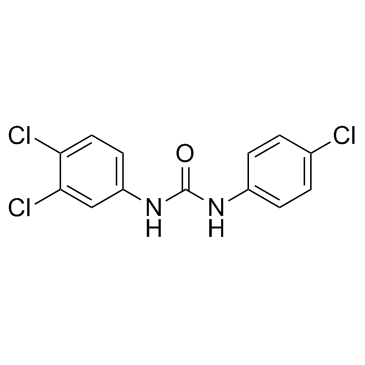Triclocarban (3,4,4′-Trichlorocarbanilide) |
| Catalog No.GC32132 |
Triclocarban (3,4,4′-Trichlorocarbanilide) (3,4,4′-Trichlorocarbanilide), a broad spectrum antibacterial compound, is widely used in a broad range of applications such as the production of soaps, skin creams, toothpastes and deodorants.
Products are for research use only. Not for human use. We do not sell to patients.

Cas No.: 101-20-2
Sample solution is provided at 25 µL, 10mM.
Triclocarban is an antimicrobial agent used in personal cleaning products.
Triclocarban at 300 nM potentiates the cytotoxicity of 300 µM H2O2 in rat thymocytes. 300 nM triclocarban itself does not increase the population of death cells, it facilitates the process of cell death induced by H2O2, resulting in further increase in the population of dead cells[1]. Triclocarban exertes estrogenic activities by inducing luciferase activities in an ER reporter gene assay, promoting the proliferation of the MCF-7 cells, up-regulating the expression of pS2 and down-regulating ERα expression at both the mRNA and protein levels in the MCF-7 cells[2].
Triclocarban is absorbed significantly from soap used during showering in human subjects and that its Cmax in their whole blood ranges from 23 nM to 530 nM[1]. Gestational triclocarban exposure does not affect the ability of dams to carry offspring to term but triclocarban exposure during lactation has adverse consequences on the survival of offspring[3].
[1]. Kanbara Y, et al. Nanomolar concentration of triclocarban increases the vulnerability of rat thymocytes to oxidative stress. J Toxicol Sci. 2013 Feb;38(1):49-55. [2]. Huang H, et al. The in vitro estrogenic activities of triclosan and triclocarban. J Appl Toxicol. 2014 Sep;34(9):1060-7. [3]. Kennedy RC, et al. Early life triclocarban exposure during lactation affects neonate rat survival. Reprod Sci. 2015 Jan;22(1):75-89.
Average Rating: 5 (Based on Reviews and 30 reference(s) in Google Scholar.)
GLPBIO products are for RESEARCH USE ONLY. Please make sure your review or question is research based.
Required fields are marked with *




















